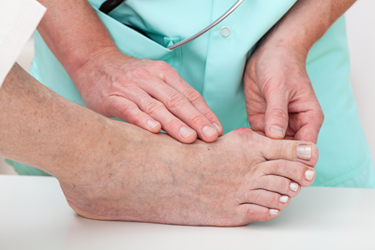
Wilmington (937) 382-2347
Fax
(513) 932-1606

Wilmington (937) 382-2347
Fax
(513) 932-1606
 A bunion is a bony bump that forms at the main joint of the big toe because the joint was pulled out of alignment. This causes the big toe to be turned towards the rest of the toes. This condition gradually develops over time and becomes more and more painful around the base of the big toe. There are a variety of factors that can lead to the formation of bunions. Biomechanical factors such as overpronation or flat feet can lead to the development of a bunion. Footwear also plays a huge role in the formation of bunions because shoes that are too tight can put pressure on the toe, and the narrow toe box of high heels can also cause bunions to form. Age can play a role in the development of bunions because the ligaments in the toes lose strength over time. Patients who are struggling with bunion pain should visit a podiatrist for a proper treatment plan that may include orthotics or surgery.
A bunion is a bony bump that forms at the main joint of the big toe because the joint was pulled out of alignment. This causes the big toe to be turned towards the rest of the toes. This condition gradually develops over time and becomes more and more painful around the base of the big toe. There are a variety of factors that can lead to the formation of bunions. Biomechanical factors such as overpronation or flat feet can lead to the development of a bunion. Footwear also plays a huge role in the formation of bunions because shoes that are too tight can put pressure on the toe, and the narrow toe box of high heels can also cause bunions to form. Age can play a role in the development of bunions because the ligaments in the toes lose strength over time. Patients who are struggling with bunion pain should visit a podiatrist for a proper treatment plan that may include orthotics or surgery.
If you are suffering from bunion pain, contact Dr. Gerald Perelman of Ohio. Our doctor can provide the care you need to keep you pain-free and on your feet.
What Is a Bunion?
Bunions are painful bony bumps that usually develop on the inside of the foot at the joint of the big toe. As the deformity increases over time, it may become painful to walk and wear shoes. Women are more likely to exacerbate existing bunions since they often wear tight, narrow shoes that shift their toes together. Bunion pain can be relieved by wearing wider shoes with enough room for the toes.
Causes
Symptoms
In order to diagnose your bunion, your podiatrist may ask about your medical history, symptoms, and general health. Your doctor might also order an x-ray to take a closer look at your feet. Nonsurgical treatment options include orthotics, padding, icing, changes in footwear, and medication. If nonsurgical treatments don’t alleviate your bunion pain, surgery may be necessary.
If you have any questions, please feel free to contact our office located in Wilmington, OH . We offer the newest diagnostic and treatment technologies for all your foot care needs.